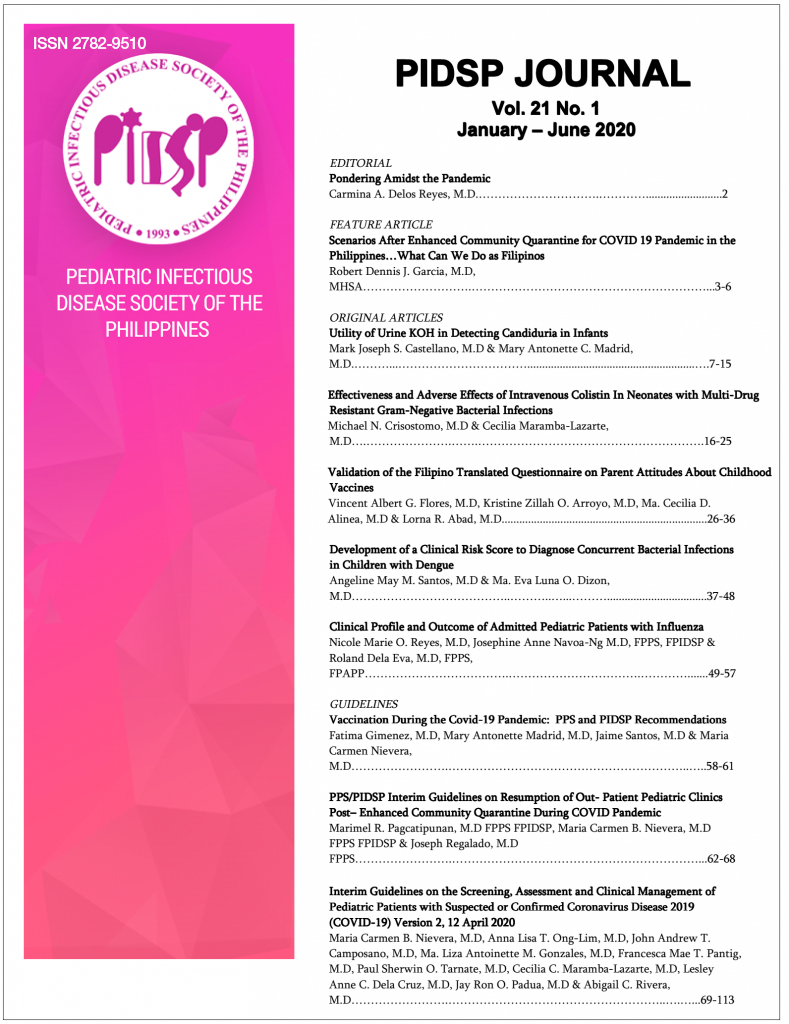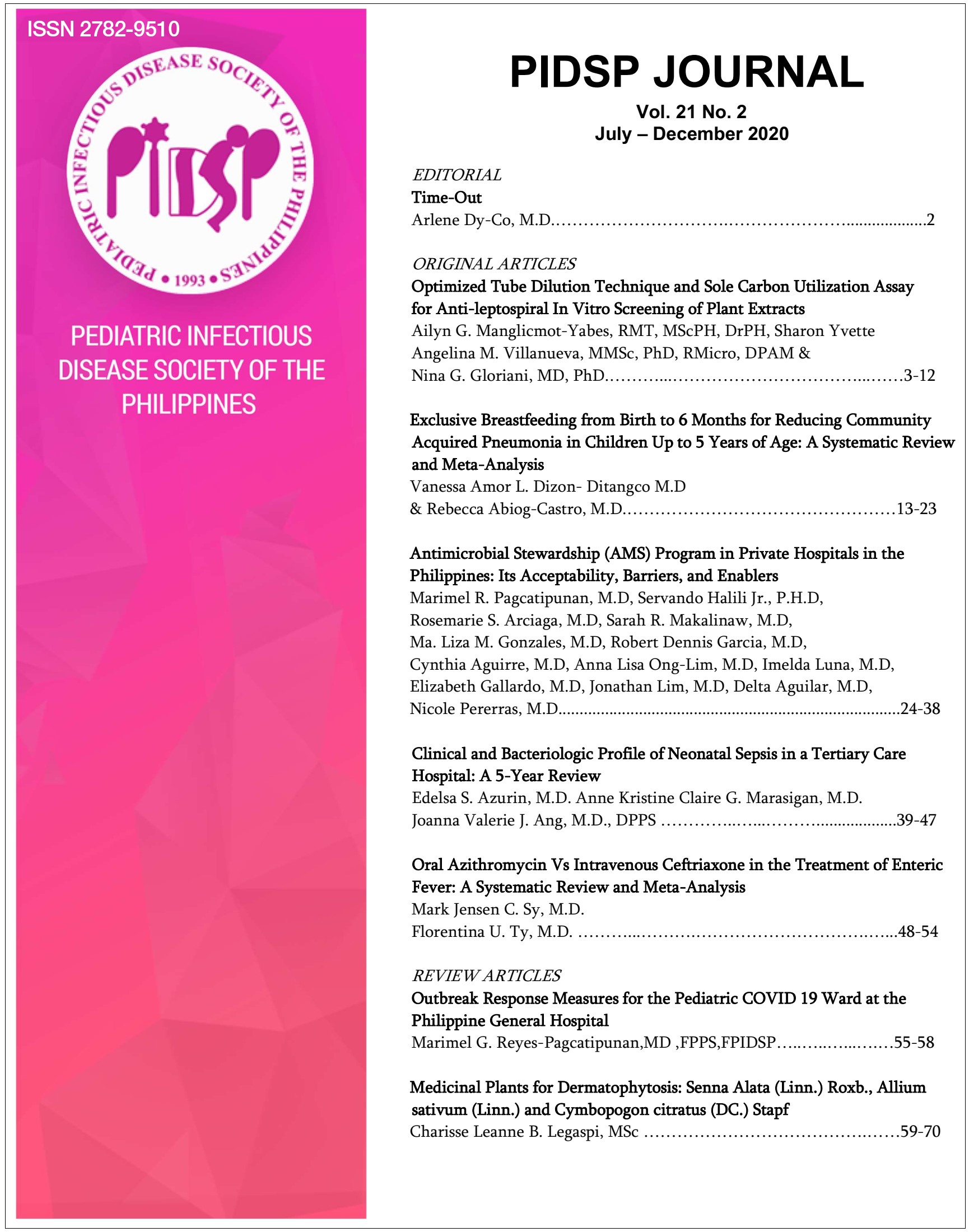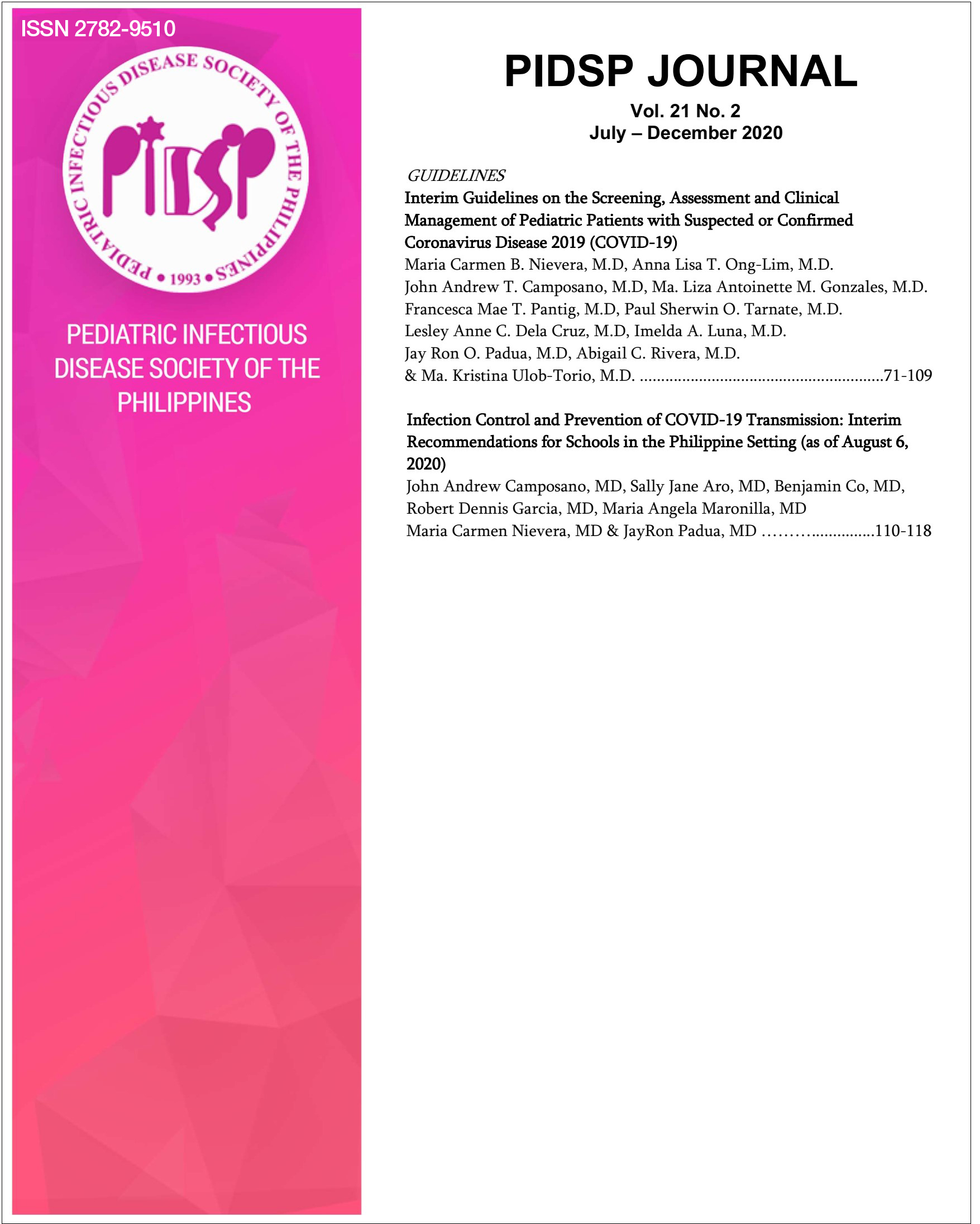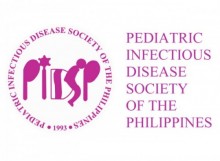2020 Journals

Pondering Amidst the Pandemic
Carmina A. delos Reyes, M.D.
| View Full Article in PDF format |
Scenarios after Enhanced Community Quarantine for COVID 19 Pandemic in the Philippines… What Can We Do as Filipinos
Robert Dennis J. Garcia, M.D., MHSA
| View Full Article in PDF format |
Original Articles
Journal 2020 Vol.21 No.1
Utility of Urine KOH in Detecting Candiduria in Infants
Mark Joseph S. Castellano, M.D & Mary Antonette C. Madrid, M.D.
Abstract
Background: Candida species are common cause of urinary tract infection in infants requiring medical care. Candida fungal elements may be demonstrated in urine using microscopic examination with potassium hydroxide (KOH). However, detection of these elements does not always correlate with candiduria.
Objectives: To establish the utility of urine KOH in identifying candiduria and to determine the risk factors, as well as urinalysis and CBC parameters associated with candiduria.
Methods: This prospective cross-sectional study included admitted infants 1 year and below with urine culture and with any risk factor/s for candiduria. Additional urine KOH testing was done using clean catch or catheter method. Urine culture was used as the gold standard.
Results: Among the 90 study participants with both urine culture and urine KOH, 13 (14%) had candiduria. The use of indwelling catheter, presence of urinary tract anomalies, positive leukocyte esterase in urinalysis, and increased monocyte counts in CBC are all associated with candiduria. Urine KOH has sensitivity of 100%, (CI 75.2-100%), specificity 59.7%, (CI 47.9-70.7%), PPV 29.5%, (CI 17.7-45.2%), and NPV 100%, (CI 92.2-100%) in detecting candiduria.
Conclusions: Negative urine KOH has excellent negative predictive value, while positive urine KOH result may warrant further investigation. Urine KOH results should be interpreted with caution depending on patient’s risk factors, clinical status, and other
laboratory results prior to initiation of empiric antifungal therapy. Positive urine KOH may not always require treatment.
| View Full Article in PDF format |
Journal 2020 Vol.21 No.1
Effectiveness and Adverse Effects of Intravenous Colistin In Neonates with Multi-Drug Resistant Gram-Negative Bacterial Infections
Michael N. Crisostomo, M.D., Cecilia Maramba-Lazarte, M.D.
Abstract
Background: The global burden of multi-drug resistant gram-negative bacterial (MDR-GNB) infections has been increasing.
Neonates are at a particularly high-risk and there is limited treatment option. The use of colistin has been re-introduced for this population. However, data on its use in neonates is scarce.
Objectives: To determine the effectiveness and adverse effects of intravenous colistin in neonates with multidrug-resistant gram-negative infections.
Design: This is a retrospective cohort study of the clinical profile and outcome of neonates with MDR-GNB infections given colistin for a minimum of 3 days conducted from April 2015 to April 2019.
Results: A total of 175 pediatric patients had MDR-GNB infections. 75 (43%) neonates met the inclusion criteri a and received intravenous colistin. Of the 75 patients with MDRGNB infections- that included sepsis, pneumonia, urinary tract infection and abscess, 37 (49.3%) were alive and 38 (50.7%) patients died. Nephrotoxicity was seen in 4% if patients and 2.6% patients had hypersensitivity reaction. MDROs isolated were Acinetobacter baumanii, Klebsiella pneumoniae and Pseudomonas aeruginosa.
Conclusions: Intravenous colistin is 50% effective and is relatively safe to use in neonates.
Keywords: colistin, MDR-GNB, neonates
| View Full Article in PDF format |
Validation of the Filipino Translated Questionnaire on Parent Attitudes About Childhood Vaccines
Vincent Albert G. Flores, M.D, Kristine Zillah O. Arroyo, M.D, Ma. Cecilia D. Alinea, M.D., Lorna R. Abad, M.D.
Abstract
Objective: To determine the content validity and test-retest reliability of the Filipino Translated Questionnaire on Parent Attitudes About Childhood Vaccines.
Methodology: Eligible parents of patients seen at the Pediatric Outpatient Department, Pediatric Emergency Room and Pediatric Wards of the Philippine General Hospital were recruited into the study. The original survey tool was translated to Filipino by the Sentro ng Wikang Filipino. A focus group of four experts in the field of vaccination rated the content of each item on the questionnaire based on its relevance. Ten Filipino speaking participants were then recruited to check its face validity. This was then implemented to 67 Filipino speaking participants to check its test-retest reliability.
Results: The overall item content validity index of the questionnaire was computed to be 0.95. All items had a 100% rating in terms of clarity and simplicity. The high intraclass correlation coefficient of 0.970 supports the tool’s test-retest reliability. However, the test had a low Cronbach’s α coefficient of 0.687 which could be increased to 0.711 with the removal of one item from the question pool.
Conclusion: The Filipino Translated Questionnaire on Parent Attitudes About Childhood Vaccines has face and content validity with an acceptable internal consistency. This can serve as a framework for future researches on vaccine hesitancy.
Keywords: immunization, vaccination, questionnaires, Filipino
| View Full Article in PDF format |
Journal 2020 Vol.21 No.1
Development of a Clinical Risk Score to Diagnose Concurrent Bacterial Infections in Children with Dengue
Angeline May M. Santos, M.D. & Ma. Eva Luna O. Dizon, M.D.
Abstract
Background: The clinical course of dengue can be adversely affected by bacterial coinfection. Because of this, clinical manifestations may be severe and may lead to morbidity and mortality. Little is known about this dual infection in the pediatric population.
Objectives: This study was conducted to evaluate the clinical characteristics and risk factors of patients with dengue infection and coinfection and subsequently develop a scoring system to diagnose bacterial coinfection in patients with dengue.
Methods: A prospective cross-sectional observational study was conducted among hospitalized pediatric patients with confirmed dengue infection between January 2019 to August 2019. Baseline characteristics, risk factors, clinical parameters, laboratory findings, management and outcomes were recorded. Cases with concurrent bacterial infections were further analyzed. A scoring system was created which assigned 1 point each for the following risk factors -age ≤9 years, fever >5 days, dengue severe, and 2 points for CRP >12 mg/l)
Results: A total of 154 pediatric dengue patients were enrolled with a mean age of 8.54 ± 4.15 years, and 99 patients (64%) had bacterial coinfection. Patients with coinfection were A total of 154 pediatric dengue patients were enrolled with a mean age of 8.54 ± 4.15 years, and 99 patients (%) had bacterial co-infection. Patients with coinfection were younger, have prolonged fever (>5 days), and were more frequently observed to have hypotension, tachycardia, desaturations and bleeding. Patients with coinfection also had higher white blood cell counts (>8 x109 cells/L), higher neutrophil counts (58.80 ± 18.42 % count), and elevated CRP (>12 mg/l) and procalcitonin (>4.01 ng/L). Utilizing the scoring system developed, a score of ≥3 had a sensitivity of 66.67% and specificity of 76.36%, in diagnosing concurrent bacterial infection in children with dengue.
Conclusions: Patients with dengue and bacterial coinfections were younger with comorbidities. They presented with significantly abnormal vital signs, physical examination findings, and elevated acute phase reactants. Using age ≤ 9 years, fever >5 days, dengue severe, and CRP >12mg/l, a scoring system was developed to diagnose bacterial coinfection in patients with dengue. A score of ≥3 can help diagnose patients with dengue and bacterial coinfection who will most likely need early empiric antimicrobial therapy.
Keywords: Dengue, Concurrent Bacterial Infection, Risk Score
| View Full Article in PDF format |
Journal 2020 Vol.21 No.1
Clinical Profile and Outcome of Admitted Pediatric Patients with Influenza
Nicole Marie O. Reyes, M.D, Josephine Anne Navoa-Ng M.D, FPPS, FPIDSP & Roland Dela Eva, M.D, FPPS,FPAPP
Abstract
Background: Influenza is one of the most common illnesses pediatricians face. Children are especially at risk for contracting
influenza. Aside from fever, cough and colds, the disease may present differently in children. Complications due to influenza are varied and anti-virals may be useful if given early in the course of illness.
Objectives: To determine the clinical profile of admitted pediatric patients with influenza based on rapid testing and determine its prevalence, outcome and complications.
Methods: Cross sectional study of pediatric patients who had nasopharyngeal swab for influenza by antigen rapid detection
test were included. Retrospective chart review was done on patients with influenza-like illness admitted from 2013-2019.
Results: There were 244 patient charts reviewed, the mean age of patients was 5 – 9 years old and majority had no influenza
vaccine during the year of admission. Patients presented with fever, cough, colds and non-specific symptoms. Ear pain, difficulty of breathing and myalgia were found to be associated with a positive influenza infection. Of the 244 suspected patients, 133 (54%) were positive for influenza rapid testing, 33% were influenza B positive and 21.3 % were influenza A positive. The most common clinical complication for influenza positive patients was pneumonia. 1 patient had respiratory failure, 5 had febrile convulsions and 7 developed viral myositis. 19% of the subjects had asthma as co-morbidity. Only 11% of the population had their annual influenza vaccine.
Conclusion: 54% of pediatric patients tested for influenza had positive tests for either Influenza A or B. Although generally a
mild illness, it contributes to morbidity and mortality in children. Complications are not uncommon in the pediatric population as seen in this study. Vaccination remains an important preventive measure to curb influenza cases.
Keywords: Influenza, Seasonal Flu, Influenza A, B
| View Full Article in PDF format |
GUIDELINES
Vaccination During the Covid-19 Pandemic: PPS and PIDSP Recommendations
Fatima Gimenez, M.D, Mary Antonette Madrid, M.D, Jaime Santos, M.D & Maria Carmen Nievera, M.D.
| View Full Article in PDF format |
PPS/PIDSP Interim Guidelines on Resumption of Out- Patient Pediatric Clinics Post– Enhanced Community Quarantine During COVID Pandemic
Marimel R. Pagcatipunan, M.D. FPPS FPIDSP, Maria Carmen B. Nievera, M.D. FPPS FPIDSP & Joseph Regalado, M.D. FPPS
| View Full Article in PDF format |
Interim Guidelines on the Screening, Assessment and Clinical Management of Pediatric Patients with Suspected or Confirmed Coronavirus Disease 2019 (COVID-19) Version 2, 12 April 2020
Maria Carmen B. Nievera, M.D., Anna Lisa T. Ong-Lim, M.D., John Andrew T. Camposano, M.D., Ma. Liza Antoinette M. Gonzales, M.D., Francesca Mae T. Pantig, M.D., Paul Sherwin O. Tarnate, M.D., Cecilia C. Maramba-Lazarte, M.D., Lesley Anne C. Dela Cruz, M.D., Jay Ron O. Padua, M.D. & Abigail C. Rivera, M.D.
| View Full Article in PDF format |

Journal 2020 Vol.21 No.2
Editorial
Time-Out
Arlene Dy-Co, M.D.
Amidst the ongoing COVID-19 Pandemic, we wonder when everything will settle down. Lives have been lost… one too many, livelihoods disrupted, events cancelled, travel plans placed on the back burner and education halted. Our country has the highest number of cases in our part of the world. We had the longest lockdown too.
| View Full Article in PDF format |
Journal 2020 Vol.21 No.2
Optimized Tube Dilution Technique and Sole Carbon Utilization Assay for Anti-leptospiral In Vitro Screening of Plant Extracts
Ailyn G. Manglicmot-Yabes, RMT, MScPH, DrPH, Sharon Yvette, Angelina M. Villanueva, MMSc, PhD, RMicro, DPAM & Nina G. Gloriani, M.D., PhD
Abstract
Introduction:
Leptospirosis is one of the neglected reemerging zoonoses that is of public health concern globally. The need to discover novel therapeutic alternatives for leptospirosis through screening for and elucidating the mechanism/s of the anti-leptospiral activity of plant extracts is therefore necessary. This study analyzes the optimized tube dilution technique and the BiologTM sole carbon utilization phenotype microarray as screening tool for anti-leptospiral activity of plant extracts.
Methods: The suitability of the optimized tube dilution technique was evaluated by determining the minimum inhibitory concentration (MIC), minimum bactericidal concentration (MBC), and motility inhibition property of a plant extract and an antimicrobial control (pen G) against 4 dominantly circulating Leptospira serovars/serogroup in the Philippines. Likewise, the suitability of the BiologTM sole carbon utilization assay was evaluated using a plant extract and selected antimicrobials against L. interrogans serovar Manilae strain K64 and L. interrogans serovar Losbanos strain K37.
Results: The MIC, MBC, and motility inhibition property of a plant extract and the antibiotic controls as well as its effect on the carbon utilization phenome of the Leptospira serovars gave consistent results, within and between several runs. With standard deviation = 0 for all serovars. The MIC and MBC of the antimicrobial control (pen G), the positive control, was 10 ug/ml. The growth control (leptospires without treatment), the negative control, showed presence of motile leptospires. The MIC and the MBC of the test plant extract was 250 ug/ml – 500 ug/ml. Results of the carbon utilization phenome or pattern of carbon utilization were consistent within the 3 replicates and between two runs.
Conclusion: The optimized tube dilution technique and the BiologTM sole carbon utilization assay is a potential in vitro screening tool for determining anti-leptospiral activity of plant extracts.
Keywords: anti-leptospiral, tube dilution technique, phenotype microarray
| View Full Article in PDF format |
Exclusive Breastfeeding from Birth to 6 Months for Reducing Community Acquired Pneumonia in Children Up to 5 Years of Age: A Systematic Review and Meta-Analysis
Vanessa Amor L. Dizon- Ditangco M.D & Rebecca Abiog-Castro, M.D
Abstract
Background:
Exclusive breastfeeding up to 6 months of age is the global recommendation of the World Health Organization because of its established benefits. Previous studies show that exclusive breastfeeding can protect infants during infancy but effects of breastfeeding beyond infancy are inconclusive. This study aims to identify if exclusive breastfeeding up to 6 months of age is protective for pneumonia up to 5 years of age.
Methods: Systematic literature search was conducted on the following electronic databases: Pubmed, MEDLINE, EMBASE, CINAHL, SciHub, Herdin, Google Scholar, the Cochrane Central Register of Controlled Trials and the Cochrane Database of Systematic Reviews to identify all relevant studies assessing the effect of exclusive breastfeeding on development of pneumonia in children from birth to 5 years of age. Fixed effects meta-analysis was performed to generate pooled effect estimates (odds ratio) on the probability of developing pneumonia up to 5 years of age in exclusively breastfed compared to non-exclusively breastfed infants.
Results: Five studies were included in the analysis. Exclusive breastfeeding from birth to 6 months has a protective effect against pneumonia in children up to 5 years of age. The probability of developing pneumonia in children until 5 years of age was significantly lower in those who were exclusively breastfed compared to those who were not exclusively breastfed (OR=0.86; 95%CI=0.77-0.95, pvalue=0.003) by 23%. Systematic review showed benefit of exclusive breastfeeding and continued breastfeeding for longer protection against developing pneumonia.
Conclusion: Exclusive breastfeeding from birth to 6 months is associated with statistically significant reduction in the incidence of pneumonia up to 5 years of age. Results highlighted the importance of exclusive breastfeeding up to 6 months of age as an intervention in reducing pneumonia morbidity up to 5 years of age, thereby supporting the global recommendation of breastfeeding.
Keywords: exclusive breastfeeding, pneumonia, breastmilk
| View Full Article in PDF format |
Antimicrobial Stewardship (AMS) Program in Private Hospitals in the Philippines: Its Acceptability, Barriers, and Enablers
Marimel R. Pagcatipunan, M.D, Servando Halili Jr., P.H.D, Rosemarie S. Arciaga, M.D, Sarah R. Makalinaw, M.D,
Ma. Liza M. Gonzales, M.D, Robert Dennis Garcia, M.D, Cynthia Aguirre, M.D, Anna Lisa Ong-Lim, M.D, Imelda Luna, M.D, Elizabeth Gallardo, M.D, Jonathan Lim, M.D, Delta Aguilar, M.D, Nicole Pererras, M.D
Abstract
Background:
Antimicrobials are drugs that are often misused and inappropriate antimicrobial prescribing often results in poor clinical outcome and drug resistance. Monitoring and regulation of antimicrobial use is currently being done by the Department of Health through the Antimicrobial Stewardship (AMS) Program. There is a need to determine the factors that affect successful implementation of an AMS program in private hospitals in the Philippines. This study was conducted to identify the enablers and potential barriers in implementing an AMS program in nine (9) private hospitals.
Methodology: A concurrent mixed methods design was used to assess various stakeholders’ (physicians, administrators, other AMS members) perceptions of existing or proposed AMS programs, and to identify barriers and enablers in their implementation. Quantitative data were collected using self-administered survey questionnaire to assess clinician’s acceptance of AMS programs. Qualitative data were collected through semi-structured one-on-one interviews of clinicians and other AMS personnel and focus group discussions (FGD) of selected clinician groups. Data were gathered from October 2018 to October 2019.
Results: 409 clinicians were surveyed, 52 were interviewed and 46 sat for 13 sessions of FGDs. Overall, the survey established that physicians were well aware of antimicrobial resistance problem. Majority of the clinicians indicated general agreement with the currently practiced antimicrobial protocols in their hospitals and with the AMS program. However, there were disagreements in perceptions with how antimicrobial restrictions impair prescribing practices and overuse of the same. These responses were strong points of discussion during the Key Informant Interviews (KII) and FGDs. All respondents were amenable with the institutionalization of an AMS program in their hospitals. The hospital leadership’s commitment was determined to be the key enabler of a successful AMS program’s implementation. Barriers identified for hospitals with existing AMS programs were: lack of dedicated staff, resistance and/or non-cooperation of physicians, lack of support from non-medical departments, and inadequate cooperation between hospital personnel. Barriers identified, regardless of the status of the AMS programs were: deficiency in knowledge with developing and implementing an AMS program, inadequate information dissemination, unavailability of an IT-based monitoring for antibiotic use, and the influence of pharmaceutical companies on stakeholders with regards to antimicrobial use.
Conclusion: Similar enablers and barriers to a successful implementation of an AMS program were seen in the different hospitals. A hospital leadership’s commitment was determined to be the key enabler. The success or failure of any AMS program appears to depend on physician understanding, commitment and support for such a program. By involving the main players in an AMS program- the hospital administrators, clinicians and other key members, perceived barriers will be better identified and overcome, and enablers will help allow a successful implementation of an AMS program.
This multi-center study was funded by Philippine Council on Health Research and Development ( PCHRD) and Pediatric Infectious Disease Society of the Philippines ( PIDSP) and was conducted by the PIDSP Research Committee.
| View Full Article in PDF format |
Journal 2020 Vol.21 No.2
Clinical and Bacteriologic Profile of Neonatal Sepsis in a Tertiary Care Hospital: A 5-Year Review
Edelsa S. Azurin, M.D., Anne Kristine Claire G. Marasigan, M.D., Joanna Valerie J. Ang, M.D., DPPS
Abstract
Background: Neonatal sepsis, a clinical syndrome characterized by non-specific signs and symptoms, is the most common cause of neonatal mortality and morbidity. It is classified into early or late-onset depending on the onset of symptoms, if within the first 72 hours or later. Early onset sepsis (EOS) occurs due to ascending infection following rupture of membranes or during passage through an infected birth canal. Late onset sepsis (LOS) can be nosocomial or community-acquired. A high index of suspicion and timely and judicious use of antibiotics are needed to achieve good outcomes.
Objective: This study looked into the clinical and bacteriologic profile of neonatal sepsis in a tertiary care hospital from January 2013 to December 2017.
Methodology: This was a retrospective observational study. Data on maternal risk factors, mode of delivery, gestational age, birth weight, birth setting, clinical manifestations, and blood culture and sensitivity were gathered. Descriptive statistics was used to analyze the data.
Results: Majority of cases were late onset sepsis with an equal distribution in those born via normal spontaneous delivery (NSD) and cesarean section (CS). There were more culture- positives in low birth weight (LBW) infants and those not delivered within a hospital. The most common maternal risk factor was UTI. Majority of culture-positive newborns presented with respiratory distress, poor feeding, fever, and irritability with respiratory distress being the most common manifestation for both EOS and LOS. Predominant isolates were CONS, E. coli and Klebsiella sp. Both E. coli and Klebsiella were resistant to both first-line empiric antibiotics – ampicillin and gentamicin but highly sensitive to piperacillin-tazobactam and imipenem.
Conclusion: Clinical signs and symptoms of neonatal sepsis are non-specific. The presence of respiratory distress, fever, poor feeding, and irritability together with other risk factors should raise suspicion for sepsis and prompt investigation and treatment. Predominant isolates seen were CONS, E. coli and Klebsiella sp. with resistance to first-line empiric antibiotics.
Keywords: neonatal sepsis, early-onset, late-onset, risk factors, clinical signs and symptoms, antibiotic sensitivity
| View Full Article in PDF format |
Journal 2020 Vol.21 No.2
Oral Azithromycin Vs Intravenous Ceftriaxone in the Treatment of Enteric Fever: A Systematic Review and Meta-Analysis
Mark Jensen C. Sy, M.D., Florentina U. Ty, M.D
Abstract
Background: Typhoid fever, also known as enteric fever, is a severe systemic illness characterized by fever and gastrointestinal manifestations that commonly affects children and young adults. It is most prevalent in SouthCentral Asia, Southern Africa, and Southeast Asia. Alternative drugs for the treatment of enteric fever have been studied to decrease toxicity and increase compliance. Oral azithromycin has been proposed and is widely studied as a suitable treatment alternative.
Objective: The objective of this study is to compare oral azithromycin with intravenous ceftriaxone in the treatment of uncomplicated typhoid fever in terms of cure, duration of fever, relapse, and adverse events.
Methodology: A systematic review and meta-analysis were done with eligible studies taken from PUBMED, MEDLINE, and Cochrane Clinical Trial Registry. Six studies passed the eligibility criteria and were analyzed using Review Manager 5.3.
Results: Azithromycin showed comparable results with ceftriaxone in terms of cure, duration of fever and adverse events. However, azithromycin proved superior in decreasing relapse.
Conclusion: Azithromycin is comparable to ceftriaxone in the treatment of uncomplicated typhoid fever in terms of cure, duration of fever, and occurrence of adverse events. Azithromycin likewised had a lower incidence of relapse.
Recommendations: We recommend conducting local trials in pediatric patients, to compare azithromycin with standard antibiotic regimen for typhoid fever, to help update local recommendations and expand choices for antibiotic use.
Keywords: enteric fever, azithromycin, ceftriaxone
| View Full Article in PDF format |
Outbreak Response Measures for the Pediatric COVID 19 Ward at the Philippine General Hospital
Marimel G. Reyes-Pagcatipunan,MD ,FPPS,FPIDSP
| View Full Article in PDF format |
Medicinal Plants for Dermatophytosis: Senna Alata (Linn.) Roxb., Allium sativum (Linn.) and Cymbopogon citratus (DC.) Stapf
Charisse Leanne B. Legaspi, MSc
| View Full Article in PDF format |

Interim Guidelines on the Screening, Assessment and Clinical Management of Pediatric Patients with Suspected or Confirmed Coronavirus Disease 2019 (COVID-19)
Maria Carmen B. Nievera, M.D, Cecilia C. Maramba-Lazarte, M.D. ,Anna Lisa T. Ong-Lim, M.D., John Andrew T. Camposano, M.D, Ma. Liza Antoinette M. Gonzales, M.D., Francesca Mae T. Pantig, M.D, Paul Sherwin O. Tarnate, M.D., Lesley Anne C. Dela Cruz, M.D, Imelda A. Luna, M.D., Jay Ron O. Padua, M.D, Abigail C. Rivera, M.D. & Ma. Kristina Ulob-Torio, M.D.
| View Full Article in PDF format |
Infection Control and Prevention of COVID-19 Transmission: Interim Recommendations for Schools in the Philippine Setting (as of August 6,2020)
John Andrew Camposano, M.D., Sally Jane Aro, M.D., Benjamin Co, M.D., Robert Dennis Garcia, M.D., Maria Angela Maronilla, M.D., Maria Carmen Nievera, M.D. & JayRon Padua, M.D.
| View Full Article in PDF format |
Year
1996 | 1997 | 1998 | 1999 | 2001 | 2002 | 2003 | 2004 | 2005 | 2006 | 2007 | 2008 | 2009 | 2010 | 2011 | 2012 | 2013 | 2014 | 2015 | 2016 | 2017 | 2018 | 2019 | 2021 | 2022
Carmina delos Reyes, M.D.
Arlene Dy-Co, M.D.
EDITORIAL BOARD:
Mary Ann Bunyi, M.D.
John Andrew Camposano, M.D.
Mary Antoinette Cuady-Madrid, M.D.
Xenia Catherine Fabay, M.D.
Elizabeth Gallardo, M.D.
Fatima Gimenez, M.D.
Jonathan Lim, M.D.
Sarah Makalinaw, M.D.
Francesca Mae Pantig, M.D.
Paul Sherwin Tarnate, M.D.
ADVISERS:
Cecilia Maramba-Lazarte, M.D., MScID, MScCT
JOURNAL MANAGER:
Patricia Navarro-Parlade, M.D.
